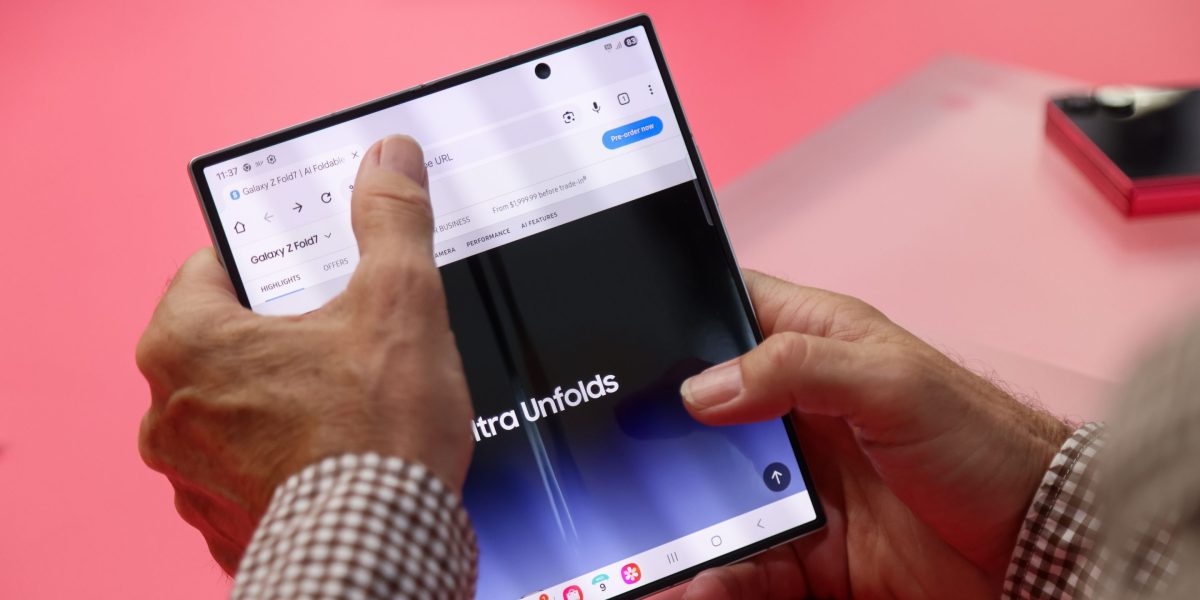Apple’s foldable phone may have been in the making for about a decade, dating back to its first flexible-display patents that were granted in 2014. But according to the latest report from Ming-Chi Kuo, one of the most experienced Apple analysts with deep connections within the tech giant’s supply chain, Apple is expected to adopt a “crease-free display solution—rather than its own design.” That design is courtesy of Samsung Display, and Apple plans to launch its first foldable phone in 2026.
“This decision will benefit suppliers closely aligned with SDC [Samsung Display], with Fine M-Tec, a supplier of display metal plates (also referred to as internal hinges), emerging as the leading beneficiary,” Kuo wrote Tuesday.
The appeal of foldable phones, in case you’ve never held or seen one in person, is that they can be small enough to fit in a pocket or bag when folded, but then be opened up to reveal a larger, nearly tablet-like screen. The ability to essentially change screen size on the fly opens up a lot of potential use cases, as well as applications.
But, as you might imagine, the successful execution of foldable phone hinges, quite literally, on the hinge. This particular issue has dogged Samsung’s own foldable phone designs, dating back to its first big swing at a foldable smartphone, the $2,000 Galaxy Fold, released in 2019. That launch, if you recall, was disastrous to say the least: After Samsung sent out review units to journalists, they quickly broke after just a day or two of normal use, with debris making its way into the hinge and bricking the display, rendering the devices useless. Samsung was forced to return to the drawing board and delay the launch of that phone “indefinitely.” (It launched five months later than it was supposed to.)
To Samsung’s credit, however, the company stuck with foldable phones, with each successive phone featuring hinges were sturdier, thinner, and more attractive.
According to Ming-Chi Kuo, Fine M-Tech, based in South Korea, will expand its production capacity in Vietnam for Apple to begin shipping foldable iPhones in the first quarter of 2026. Kuo expects shipments to reach 13-15 million units next year—and he says Apple will institute “stricter crease-free display requirements,” including laser drilling, to “better guide stress distribution and enhance crease resistance.”
Creasing in the displays of foldable phones is inevitable. However, Kuo says the Samsung Display design prevents major creasing from occurring by preventing the screen from bending beyond certain limits. It’s unclear what that would look like in regular, practical use.
For what it’s worth, this wouldn’t be the first time Apple leaned on Samsung. Despite the two holding some pretty fierce battles in courtrooms over the years—a U.S. jury awarded Apple $1.05 billion in 2011, ruling Samsung “slavishly” copied iPhone elements for its own devices—Samsung Display was the exclusive supplier of the first-ever OLED screen for the iPhone X in 2017. iPhone teardowns also typically reveal Apple buying chips from Samsung’s subsidiaries for memory and storage.
Kuo’s latest note follows his May report that laid out what he believes will be Apple’s iPhone pipeline from 2025 to 2027. He said to expect four new iPhones this fall—the iPhone 17, iPhone 17 Slim, iPhone 17 Pro, and iPhone 17 Pro Max—as well as a cheaper iPhone 17 variant, the iPhone 17e, early next year. Fall 2026 will be a different story, however, with Kuo predicting three new iPhone 18 models—Slim, Pro, and Pro Max—as well as the iPhone Foldable. The Information previously reported Apple will split its iPhone launches starting next year so it can release the more expensive variants first, before launching the standard, more affordable models several months later.
According to a recent UBS note, the bill of materials for Apple’s foldable iPhone may be around $750, which would allow it to price the phone in the $1,800-$2,000 range, in line with Samsung’s own foldable phones.
Apple, as a general policy, does not comment on rumors or reports regarding its future products, given the company’s longstanding emphasis on secrecy.
